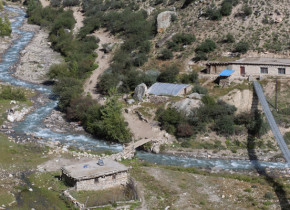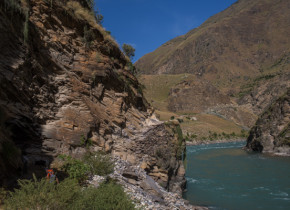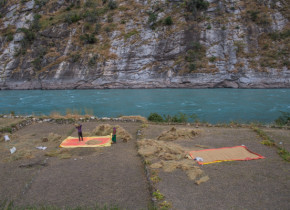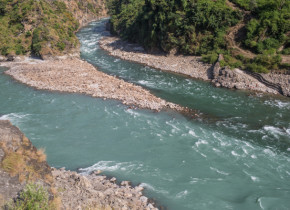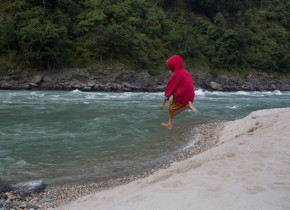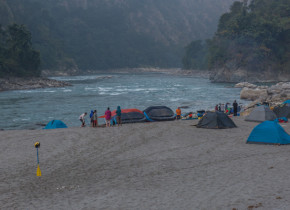The Last Free Flowing River of Nepal
Karnali is Antecedent River. The river is older than the Himalaya. The water of Karnali is cutting its path overs millions of years as the Himalaya rose. Gandaki, Koshi and Karnali are the majors rivers in Nepal emerging from Himalaya. The Karnali is the only river that remains free-flowing. All other rivers including most of their tributaries have been dammed for hydropower generation. Currently, 43 hydropower dams producing over 1MW are already in operation, and another 83 dams are currently under construction. In total, over 350 hydropower dams are slated for development.
The 900 MW Upper Karnali Hydropower Project (UKH), the first of three projects proposed on the Karnali River, would be the largest dam in Nepal. This massive and controversial storage project will dewater 50 kilometers of stream channel for nine months during low flow season.
The Mapcha Khambab river of Tibet becomes Karnali in Nepal and Ghaghara in India. The trans boundary Himalayan River Karnali travels 1100 Kilometers from the source Tibetan Platue in China through the mountains of Nepal to the confluence in Gangatic plain in India. Karnali travels 507 kilometers, making it longest river in Nepal.
Although the Karnali is still flowing freely in Nepal section, two dams in Tibet and one barrage in India disturbs its flow in northern and southern part.
Due to its trans boundary nature the river is lifeline for the millions of people living upstream in Tibetan Platue , mountains of Nepal and down stream in Indo Gangatic plain. The river basin is also rich in its biodiversity. The Sacred Karnali Corridor has one of the most and rare beautiful gifts of nature like Snow leopard, Royal Bangel Tiger, One Horned Rhino, the Golden Mahseer Fish, Ganges River Dolphin and Longfin Freshwater Eel. The free flowingKarnali is living heritage of the earth; it should be protected and used in sustainable way.
- Mount Kailash in Tibet. Four large rivers originate from four sides of Mount Kailash the Brahmaputra [called Yarlung-Tsangpo in China] from the east, the Karnali from the south, the Sutlej from the west and the Indus from the north.
- Mapcha Khambab river in Tibet, Chaina. The river was named after a spring which means the river originating from the mouth of the mountain that looks like peacock. The Mapcha Khambab river becomes Karnali in Nepal and Ghaghara in India
- Mapcha chungo spring: Mapcha Chungo spring is the spiritual source of Karnali river which is called Mapcha Khambab river in Tibet. The river was named after this spring which means the river originating from the mouth of the mountain that looks like peacock. The Mapcha Khambab river becomes Karnali in Nepal and Ghaghara in India. It is the largest tributaries of the Ganges by volume.
- Hilsa: Hilsa is a small seasonal town in Nepal- Tibet border where the Mapchakhambab river becomes Karnali. Most of the people have hotel business as the pilgirms and tourists especially from India use this route to go to Mount Kailash. During the winter the hoteliers shut down and move down to lower elevation as it snows thick and then return back in March/ April once the tourist season starts and stay till September/ October.
- Karnali River in Humla.
- Karnali river passing through Shiva’s gorge near Tomkot Village in Humla District of Nepal.
- Karnali and Yari River Confluence in Tumkot.
- Yari Khola, Humla.
- Tributary of Karnali River Nepal
- Karnali river in Muchu as it passes through semi desert and alpine forest in Humla District of Nepal.
- Karnali River in Humla.
- Karnali River in Yangar Village in Humla District of Nepal.
- Karnali River Humla
- Karnali River in and Chaya water fall Humla District of Nepal.
- The stone fish down the Chauganfhya village in Humla.
- Hepka khola , the Tributary of Karnali River Nepal
- The last free flowing River of Nepal
- A wild and scenic view of Karnali River near Lali Village in Humla District of Nepal.
- A wild and scenic view of Karnali River near Lali Village in Humla District of Nepal.
- A wild and scenic view of Karnali River near Lali Village in Humla District of Nepal.
- Ghaiya Rice cultivated on slope by the side of Karnali River in Humla .
- The last free flowing River of Nepal
- The last free flowing River of Nepal
- The last free flowing River of Nepal
- The last free flowing River of Nepal
- The last free flowing River of Nepal
- The last free flowing River of Nepal
- Karnali River in Sarkegad village in Humla District of Nepal.
- A view of Karnali river with a tree in Sarkegad Rural Municipality in Humla District of Nepal.
- Karnali River in Humla District of Nepal.
- The last free flowing River of Nepal
- Karnali River passes through the gorge that seperate two district Humla and Mugu of Nepal.
- The last free flowing River of Nepal
- The last free flowing River of Nepal
- Rice tarracees on the flood plain of Karnali River below Shreenagar village of Humla.
- Karnali River near Shreenagar of Humla District of Nepal.
- A long exposure view of Karnali River below Shreenagar village of Humla.
- The last free flowing River of Nepal
- The last free flowing River of Nepal
- Workers working to build Karnali Corridor in Humla .
- Mugu Karnali meets the mainstrem Karnali view from Humla District.
- Mugu Karnali meets the mainstrem Karnali view from Humla District.
- The last free flowing River of Nepal
- People harvest Rice from the field at the flood plain of Karnali in Bajura district of Nepal.
- The last free flowing River of Nepal
- The last free flowing River of Nepal
- The last free flowing River of Nepal
- The last free flowing River of Nepal
- Construction of Karnali Coridor in Nepal’s Bajura. Haphazard construction has increased vulnerability of the communities in the fragile landscape.
- scaveter on Karnali Corridoe in Bajura.
- The last free flowing River of Nepal
- Chudari Village in Bajura sits on the landslide debris on the bank of Karnali River. There are mny villages along Karnali River are on this kind of old landslides.
- The last free flowing River of Nepal
- The last free flowing River of Nepal
- The last free flowing River of Nepal
- The last free flowing River of Nepal
- The last free flowing River of Nepal
- The last free flowing River of Nepal
- The last free flowing River of Nepal
- Karnali River in Balde of Accham district of Nepal.
- The last free flowing River of Nepal
- First Scientific Expidition team in Karnali River decends at God’s House rapid, one of the world class rapid in the world in Karnali river boarding Achham and Surkhet.
- The confluence of West seti and Karnali Riiver.
- A long exposure night view of camps by the side of Karnali River in Kailali District of Nepal.
- Karnali River in Surkhet District of Nepal.
- A guide jump into karnali river during the rafting
- The last free flowing River of Nepal
- A raji fishing in Ghatgaun .
- Ghatgaun Home of Raji community, fisharman’s community, Nepal
- The last free flowing River of Nepal
- Chisapani: Place where the Karnali river crosses the east-west highway of Nepal. Known for a unique kind of bridge claimed as second of its kind in Asia. The Japanese constructed the single- pillar bridge. It also connects popular national park called Bardia National Park. It is the stop over place for the highway travellers for fish dishes.
- A Sonaha woman looking for gold in Karnali River .
- A view of sunset on Karnali River at Kailali District in Nepal.
- Two one horned Rhinos are seen in Geruwa water sectiion of Karnali river in Bardiya National Park in Bardiya District of Nepal. The flood plains of the Karnali river is the source of water for mega species like Tiger and Rhino—the endangered species. It covers an area of 968 square kilometres and is the largest and least disturbed national park in Nepal’s southern plains.
- The last free flowing River of Nepal
- The last free flowing River of Nepal
- Girijapuri barrage: It is the first barrage in Karnali river in India’s Uttar Pradesh district. The river is called Ghaghara in India where most of the water from the river gets diverted to Sharda river west of it.
- Ganga/Ghaghara confluence After flowing for about 1080 kilometres from the source in Tibet, the Karnali/ Ghaghara river meets the Ganges about 100 kilometers northwest of Patna—the capital city of Bihar province. It flows as Ganga thereafter and enters Bangladesh where it meets the Brahmaputra. Both rivers then reach the Bay of Bengal in the Indian Ocean.








